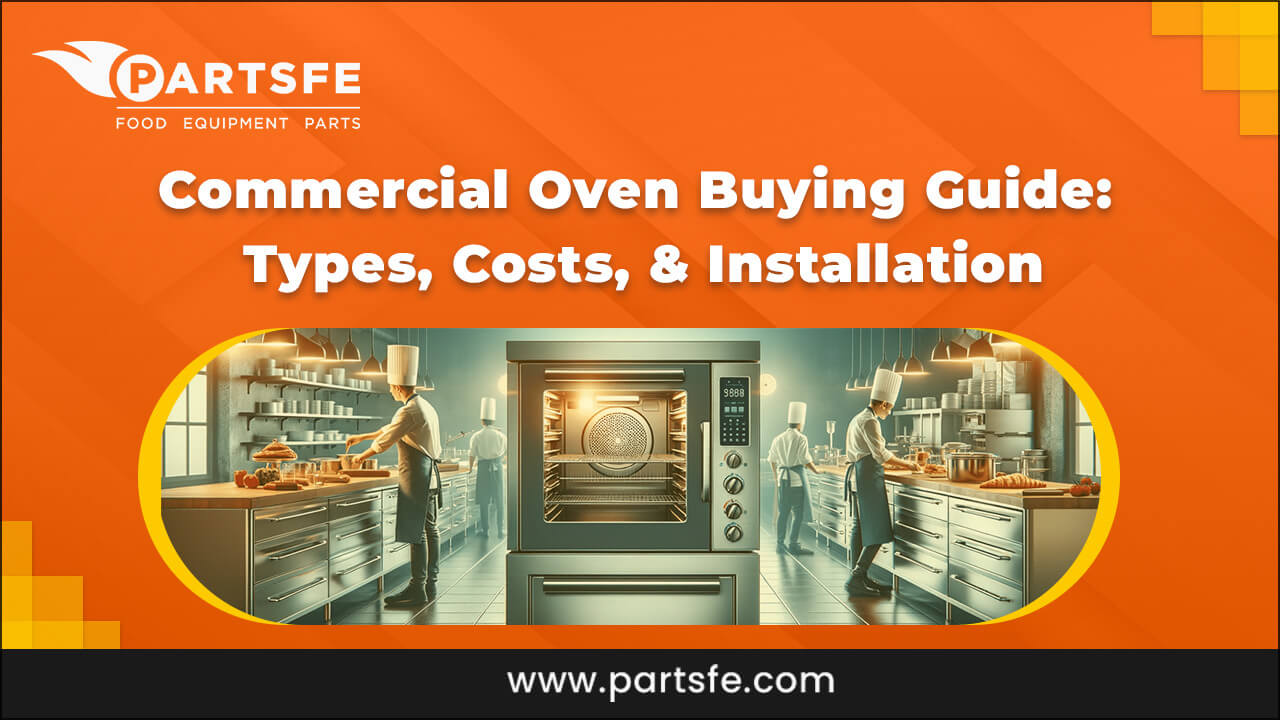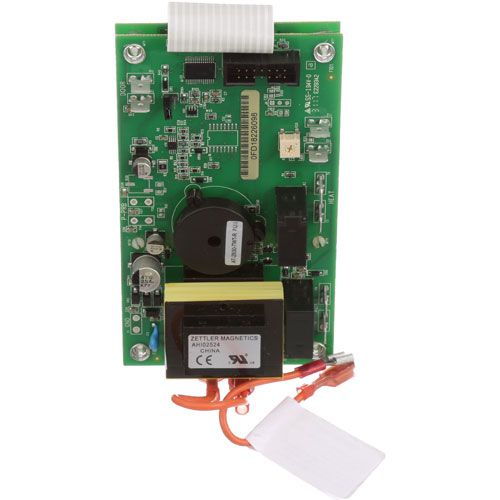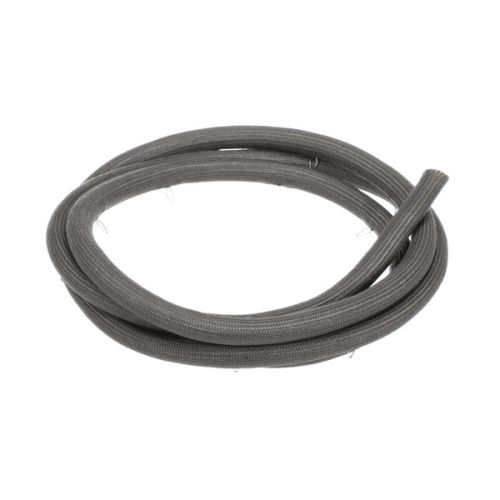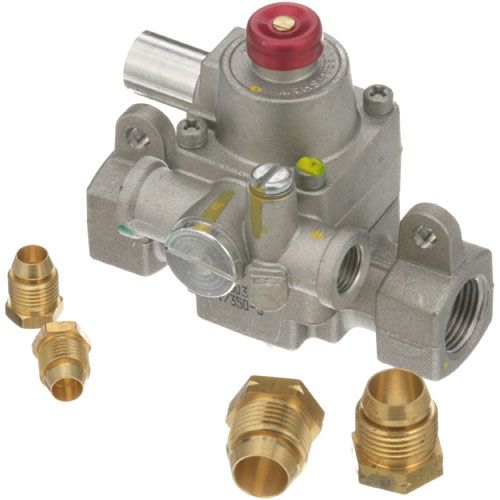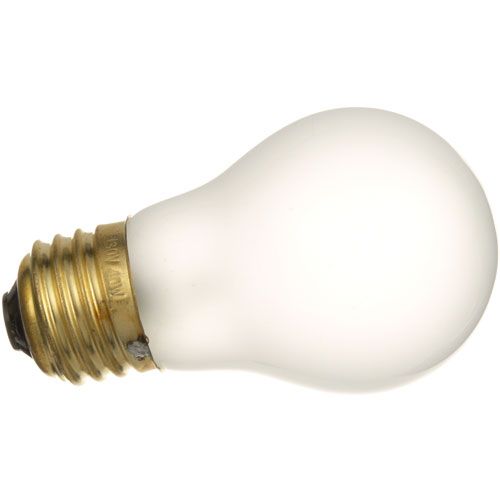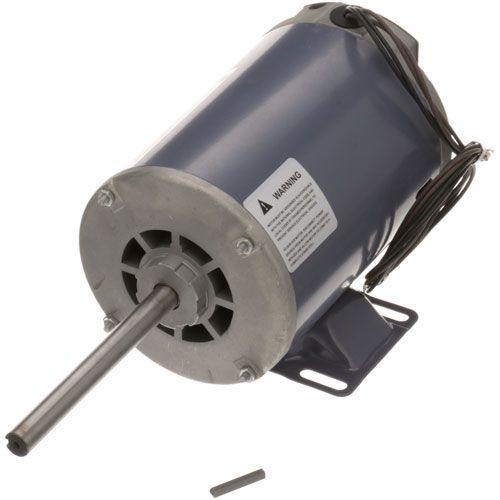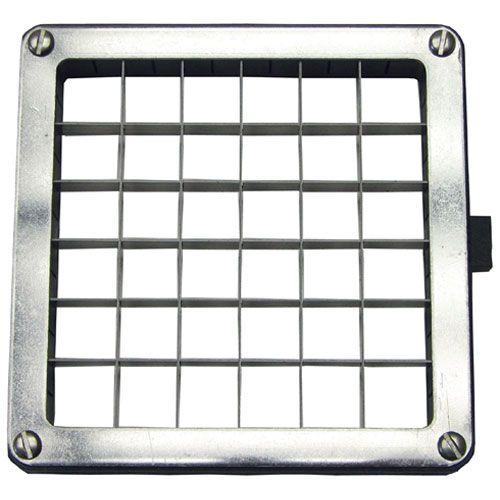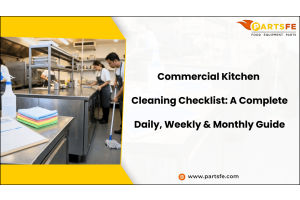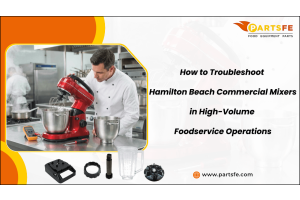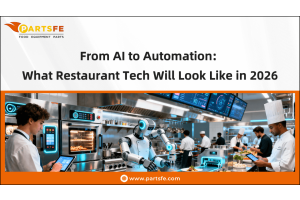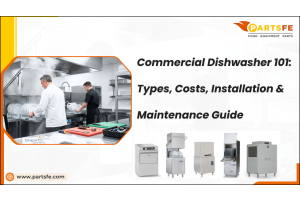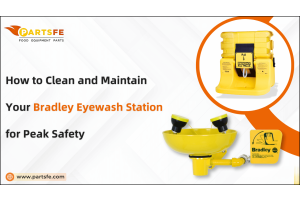Commercial Oven Buying Guide: Types, Costs, & Installation
Commercial ovens are intended for use in commercially run kitchens in restaurants, cafes, bakeries and similar outlets for use by chefs and other food preparers. Such ovens are designed to be used frequently and can bake as many foods as possible at very short intervals. There are many types of commercial ovens, namely convection ovens, deck ovens, conveyor ovens all with different characteristics. If you are looking for high-quality restaurant oven parts from top-selling manufacturers? Look no further than PartsFe! With a wide selection of oven parts from popular brands, you can trust PartsFe to provide reliable and durable solutions for all your repair and replacement needs.
For restaurants and other businesses in the food service industry, a commercial oven is an essential piece of equipment. It can greatly increase productivity, improve the quality of the food being served, and help to streamline operations. Choosing the right commercial oven can be a daunting task, however, with many factors to consider, including the type of oven, the cost, and the oven installation process. With the help of this comprehensive guide to buying a commercial oven, you will get to know about everything from the different types of ovens available to the cost and installation process. By the end of this post, you will have the knowledge you need to choose the best commercial ovens for your business.
|
Table Of Contents: |
Types of Commercial Ovens
Commercial grade ovens come in various types, each with its own unique features and functions:
Standar Ovens: These are the most basic oven types available for commercial use. Standard ovens can cook most food products, but it may not evenly cook certain types of food. They are also known as "radiant ovens" and are used for basic cooking and baking needs.
Convection Ovens: Similar to standard ovens, convection ovens provide air circulation to the cooking process. Fans installed in these commercial baking ovens to help circulate warm air inside the oven to evenly cook the product. Convection ovens are used for baking bread and pastries.
Combi Ovens: Combi ovens, also known as "combination ovens," are a marriage between steam and convection ovens. They have the capabilities to do both, which makes them versatile and fast. Combi ovens can cook food quickly and consistently and are used for baking breads, pastries, vegetables, and rice.
Conveyor Ovens: These ovens utilize a system consisting of convection cooking and a conveyor belt. They are perfect for fast-casual restaurants that need to cook large quantities of food quickly. Some conveyor ovens are available with forced air impingement, which pulls moisture from the product's surface and reduces total cooking times by as much as 20% to 25%. Conveyor ovens are used for pizzas and toasted sandwiches/paninis.
Cook-and-hold Ovens: These ovens are designed to both slow cook food and provide a holding cabinet for the finished product. They help reduce product shrinkage and keep food at a safe, ideal temperature throughout service. Cook-and-hold ovens are used for roasting meat, vegetables, and dough proofing.
Deck Ovens: Deck ovens sport large stone shelves that are heated via a heating element to cook and bake products. Brick ovens are a recognizable type of deck oven predominantly used in pizzerias. These are the best commercial baking oven that are used for baking and pizzas.
Rotisserie Ovens: Rotisserie ovens are a specialized oven types used primarily for cooking and roasting large portions of meat. The meat is rotated on a spit over a heating element, allowing the product to evenly cook as it spins. Rotisserie ovens are used for cooking large amounts of meat.
Steam Ovens: Steam ovens are a healthy alternative to frying certain foods. They cook the product using steam and can evenly cook food fast while keeping in the nutrients of the food item. Steam ovens are used for cooking vegetables.
Gas vs. Electric Ovens: When deciding on an commercial kitchen oven, one of the biggest decisions you'll need to make is whether it should be gas or electric. Gas oven parts cost less to own over a prolonged period of time, heat up quickly, and are ideal for high-output cooking. However, they require a gas connection, safety precautions and equipment need to be utilized, and they could yield uneven cooking if not monitored properly.

On the other hand, commercial electric ovens are easy to install, can be energy-efficient, cook food more evenly, but require a large amount of electricity to operate and take longer to heat up in order to cook. They are best for lower product output, unless the oven is specifically rated at a higher voltage.
What are the advantages of the restaurant oven?
Here are some of the advantages of commercial grade ovens for restaurants:
Increased Efficiency: In a commercial kitchen, time is of the essence. Ovens can help increase efficiency by allowing chefs to cook multiple dishes at once. This means that chefs can prepare a large quantity of food in a shorter amount of time, reducing wait times for customers and increasing overall productivity in the kitchen.
Consistent Quality: Consistency is key in commercial kitchens, especially in restaurants where customers expect the same quality of food every time they visit. Restaurant ovens can help ensure consistent quality by providing a controlled cooking environment. This allows chefs to cook food to the same standard each time, ensuring that customers are satisfied with their meals.
Versatility: Commercial kitchen oven are designed to be versatile, allowing chefs to cook a variety of dishes. In addition to baking and roasting, ovens can also be used for grilling, steaming, and even smoking food. This versatility allows chefs to experiment with new techniques and create unique dishes.
Space-Saving: Commercial kitchens are often short on space, and ovens can take up a significant amount of room. However, many commercial kitchen oven are designed to be space-saving, with compact designs that can be stacked on top of each other. This allows chefs to maximize their use of space in the kitchen.
Energy Efficiency: Restaurant ovens are designed to be energy-efficient, which can help reduce utility costs for restaurants. Many ovens are equipped with features such as convection heating and programmable timers that can help reduce energy consumption. Additionally, some ovens are designed to be ventless, which eliminates the need for expensive ventilation systems.
Durability: Commercial ovens for restaurants are built to withstand the rigors of a busy kitchen. They are made with durable materials that can withstand high temperatures and frequent use. This means that commercial ovens can last for years, providing a reliable cooking tool for chefs.
Safety: Commercial ovens for restaurants are designed with safety in mind. They are equipped with features such as automatic shut-off and temperature controls to prevent overheating and fires. Additionally, many ovens are designed with easy-to-clean surfaces, reducing the risk of cross-contamination and ensuring the safety of customers.
How to choose a commercial ovens for restaurants?
Choosing the right commercial oven for your restaurant is a crucial decision that can impact the quality and efficiency of your kitchen operations. Here are some factors to consider when choosing a commercial grade ovens:
Cooking Needs: The type of food your restaurant serves and the quantities you need to prepare will impact the type of oven you should choose. For example, a pizza parlor will require a high-temperature oven that can cook pizzas quickly, while a bakery will need a commercial bakery oven with multiple shelves and the ability to bake at lower temperatures for extended periods.
Cooking Speed: How quickly you need to prepare food will also impact your oven choice. Some ovens, such as cook-and-hold cabinets, have longer cooking times than others. On the other hand, rotisserie ovens can cook full spits of chicken in an hour.
Ease of Use: It's important to consider your kitchen staff's capabilities when selecting an oven. Complicated models might require additional training, which can be a challenge for new hires or inexperienced staff. Consider simpler models if your staff isn't familiar with complex ovens.
Size: The size of your kitchen is a significant factor when selecting an oven. Ensure that you measure your available space carefully to avoid buying an oven that doesn't fit. Keep in mind that the outer dimensions of the oven might not necessarily reflect its capacity. Many brands offer large capacity in relatively compact ovens.
Utilities: The type of oven you choose will depend on the dishes you cook and the utilities available in your kitchen. A gas oven might be ideal, but it may not be possible if you need to redo your infrastructure. CCommercial electric pizza oven are generally easier to install, but they may not be as powerful as gas ovens.
Ventilation: Most commercial ovens require some form of ventilation. Ensure that you have proper ventilation vents in place or have a plan to install them to accommodate your new oven.
Cost: Consider your budget and the cost of a new commercial ovens for restaurants, including installation, maintenance, and repair costs. While it's important to stay within your budget, it's also essential to invest in a high-quality oven that can meet your needs and last for a long time.
How much does a commercial kitchen oven cost?
Commercial kitchen oven come in different types, sizes, and brands, so the cost can vary significantly. Then how much does an oven cost? There are several factors to consider when estimating the cost of an oven:
|
Commercial kitchen oven types |
Cost Ranges |
| Gas Ovens | $400 and $1,500 |
| commercial electric oven | $500 and $2,000 |
| Dual fuel Ovens | $1,500 to $6,000 |
| Convection ovens | $600 to $2,000 |
Sizes of Ovens: The size of the oven will also affect the cost. Here's a rough estimate of how much you can expect to pay for different sizes of ovens:
Small Ovens: These are typically 18 to 24 inches wide and cost between $400 and $1,000.
Medium Ovens: These are typically 24 to 30 inches wide and cost between $500 and $2,000.
Large Ovens: These are typically 30 to 36 inches wide and cost between $1,000 and $6,000.
Features of Ovens: The features of an oven can also affect the cost. Here are some common features and their price ranges:
Self-Cleaning: Self-cleaning ovens cost around $600 to $2,000.
Digital Controls: Ovens with digital controls cost around $500 to $1,500.
Extra Racks: Additional racks for an oven can cost between $50 and $200.
Built-In Microwaves: Built-in microwaves can cost between $300 and $1,000, depending on the brand and features.
What are the best commercial oven brands in 2025?
When it comes to commercial ovens, choosing a reliable and high-quality brand is crucial for any foodservice operation. The best commercial ovens brands in 2025 are those that offer exceptional performance, durability, and value for money.
Vulcan: It is a renowned brand that has been providing commercial-grade kitchen equipment for over 150 years. They are known for their innovative and durable products that are designed to meet the specific needs of the foodservice industry. Vulcan commercial oven is highly regarded for their energy efficiency, and durability.
Southbend: Southbend offers a wide range of ovens, ranges, and other equipment. Their products are known for their exceptional performance, durability, and reliability. Southbend's commercial ovens are designed with precision and attention to detail, making them a popular choice for restaurants, cafes, and other foodservice operations.
Hobart: Hobart is known for their innovative and reliable products that are designed to meet the specific needs of the foodservice industry. Hobart's commercial ovens are highly recommended for their exceptional performance.
Imperial: Imperial is a trusted brand that has been providing commercial-grade kitchen equipment for over 60 years. Imperial's commercial ovens are high-quality products that are designed to meet the demanding needs of the foodservice industry.
Blodgett: Blodgett is a respected brand that has been providing commercial kitchen equipment for over 150 years. Blodgett's commercial ovens are well-known for their ease of use and performance.
Garland: Garland is a well-established brand that has been providing commercial-grade kitchen equipment for over 140 years. Garland's commercial ovens are highly regarded for their exceptional performance, energy efficiency, and durability.
Most common oven replacement parts
Commercial ovens are relied upon to provide consistent and reliable performance to cook food to perfection. However, with frequent use, the parts of the oven can wear down or become damaged. It leads to the need for oven replacement parts.
Here are the most common oven replacement parts for commercial ovens:
Thermostats: Thermostats are responsible for regulating the temperature inside the oven. They sense the heat inside the oven and turn the heating elements on and off as needed to maintain a consistent temperature. Over time, thermostats can become inaccurate or malfunction, leading to temperature fluctuations inside the oven. This can affect the quality of the food and increase cooking times. If you're unsure about the oven thermostat replacement cost, then read on this article.
Door Gaskets: Door gaskets are the rubber seals around the oven door that keep the heat inside the oven. If the door gasket becomes worn or damaged, heat can escape from the oven, causing it to lose heat and affecting the cooking times. This can also increase energy costs.
Heating Elements: Heating elements are responsible for producing the heat inside the oven. They can become damaged or burnt out over time, which can result in uneven cooking or no heat at all. Replacement heating elements can ensure that the oven is working at its best and providing consistent cooking results.
Igniters: Igniters are responsible for lighting the gas burners in gas ovens. They can become worn or damaged over time, leading to difficulties in lighting the oven or no heat at all. Replacement igniters can ensure that the oven is working properly and safely.
Thermocouples: Thermocouples are safety devices that detect if the gas flame in a gas oven has gone out. If the thermocouple detects that the flame has gone out, it will shut off the gas supply to the oven, preventing gas from leaking into the room. If the thermocouple becomes faulty or damaged, it may shut off the gas supply unnecessarily, causing inconvenience and delays.
Motors and Fans: Motors and fans are responsible for circulating the air inside the oven, ensuring that the heat is distributed evenly. If the motor or fan becomes damaged, it can affect the cooking times and result in unevenly cooked food. Replacement motors and fans can ensure that the oven is working at its best and providing consistent results.
How to install a commercial oven?
Installing a commercial oven requires careful planning and attention to detail. Here are the general steps you should follow for oven installation:
-
Choose a suitable location for the oven that meets local building and safety codes.
-
Ensure that the power supply and ventilation system are adequate for the oven's requirements.
-
Assemble the oven according to the manufacturer's instructions.
-
Place the oven in its designated location and secure it to the floor or wall as required.
-
Connect the oven to the power supply and ventilation system, following all safety guidelines.
-
Test the oven to ensure it is working properly before use.
-
Train staff on how to operate the oven safely and efficiently.
Buying a commercial oven requires careful consideration of various factors. By understanding the different types of ovens mentioned above in the article, you can make an informed decision that aligns with your business needs and budget. Additionally, it's crucial to invest in a quality oven that is energy-efficient and durable to ensure long-term cost savings. Proper oven installation is also essential to ensure optimal performance and safety. With these factors in mind, you can confidently purchase a commercial oven that will serve your business needs for years to come.
FAQs
How much does oven installation cost?
The cost of oven installation can vary depending on factors such as the type of oven, location, and complexity of the installation. On average, the cost can range from $50 to $200.
What type of oven should I buy?
Consider your restaurant needs and preferences before purchasing a commercial oven. Common types of ovens include conventional, convection, and microwave ovens. You may also consider factors such as size, features, and brand when making a decision.
How long does it take to cook chicken breast in the oven?
The cooking time for chicken breast in the oven can vary depending on factors such as the size and thickness of the chicken. As a general rule of thumb, a 4-ounce chicken breast should be cooked at 350°F for 25-30 minutes, while a 8-ounce chicken breast should be cooked for 35-40 minutes.
How to bake a potato in the oven?
To bake a potato in the oven, preheat the oven to 400°F. Wash the potato and poke a few holes in it with a fork. Rub the potato with oil and sprinkle it with salt. Place the potato on a baking sheet and bake for 45-60 minutes, or until the potato is tender when pierced with a fork.
Which is the best commercial oven for baking bread?
The best commercial ovens for baking bread is a deck oven.
What are the top options for a commercial rotisserie oven?
The best commercial rotisserie ovens include gas rotisserie ovens and electric rotisserie ovens.
What should I look for in a commercial electric convection oven for bakeries?
Look for even heat distribution and temperature control in a commercial electric convection oven for bakeries.
What is the best commercial oven for baking cookies?
The best commercial oven for baking cookies is the convection oven, as it provides even heat distribution and consistent airflow, ensuring perfectly baked cookies every time.

